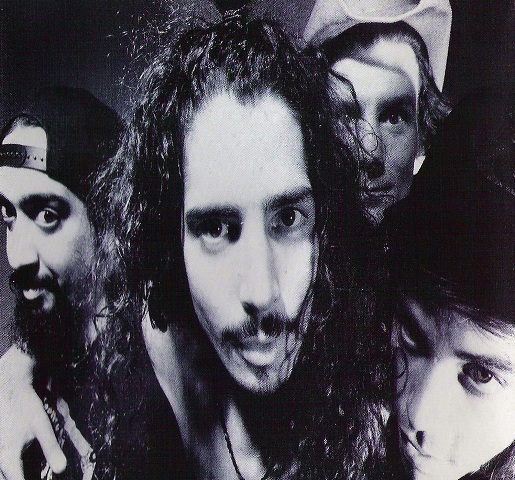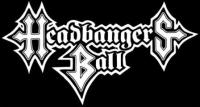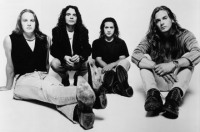Eönian Records: Where Metal Lasts Forever ...
If hard rock and heavy metal were forged in the cauldron of conflict that was the 1970's, their prettier, poppier stepbrother known as glam-metal or hair-metal exploded into popularity during the extreme excess of the 1980's. The ‘70’s may have actually ushered in the sexual revolution, but it was the ‘80's metal scene that turned the topic into a non-taboo and stalwart lyrical mainstay. Rarely has the mantra “sex, drugs, rock ‘n’ roll” been as prevalent as it was during the ‘80's metal scene. It was an era of bombastic excess and the metal of the day reflected it like a coke-dusted compact mirror.
The Promised Land for this sex-and-sin-fueled symphony was the Sunset Strip in Los Angeles, the location and the sound so inextricably intertwined that hair-metal was often simply referred to as “L.A. metal.” During the decade of decadence and debauchery, it seemed like there were more metal clubs on the Strip than there were bands to play them. Being in a hard rock or metal band back in the ‘80’s, almost automatically meant a mandatory migration to the City of Angels.
 Skid Row in 1989The sleazy, fun-loving Sunset Strip metal sound enjoyed a good run, making household names out of the likes of Poison, Cinderella, Warrant, Skid Row, and a host of others. The style was so popular that even so-called second tier bands like Autograph, Babylon A.D., and Black N Blue saw moderate success. Denim and leather wearing bad boys went wild for the fist-pumping, head-banging anthems, the hot chicks with tight bodies and tighter clothes fell in love with the bands’ long-haired masculinity and romantic power ballads, and the cross-gender appeal resulted in chart-topping success.
Skid Row in 1989The sleazy, fun-loving Sunset Strip metal sound enjoyed a good run, making household names out of the likes of Poison, Cinderella, Warrant, Skid Row, and a host of others. The style was so popular that even so-called second tier bands like Autograph, Babylon A.D., and Black N Blue saw moderate success. Denim and leather wearing bad boys went wild for the fist-pumping, head-banging anthems, the hot chicks with tight bodies and tighter clothes fell in love with the bands’ long-haired masculinity and romantic power ballads, and the cross-gender appeal resulted in chart-topping success.
As is so often the case, success led to over saturation, and in 1990 the scene began to systematically dismantle itself. Agency reps and label scouts signed any band with brightly-hued spandex and hair teased into the stratosphere. The image became more important than the music, looking good on an album cover given more credence than the actual album itself. Rigid adherence to the cock-rock formula became the norm and creative ferocity was trampled beneath the greedy rush to sell pretty boy pin up posters. Having ruled the hard rock world for a decade, hair metal became a bloated snake eating its own tail. And bursting forth like a spew of maggots from glam-metal’s gutted, self-devouring corpse arose a new genre known as grunge.
 Soundgarden in 1991If commercial metal’s unchecked and foolish tendency toward self-cloning pushed the genre right up to the edge of destruction and left it teetering there, grunge is responsible for giving it that final shove that sent it flailing into the abyss. Like kids chowing down on too much Halloween candy, hard rock fans had grown sick of the overblown theatrics and saccharine bombast of pop-metal and were ready for a taste of something different, and strangely-named bands like Nirvana, Pearl Jam, and Soundgarden were different enough to taste downright exotic. The crisp, clean, fiery guitars of glam-metal were drowned out by the dark, distorted, down-tuned guitars of grunge; the tongue-in-cheek lyrics about sex and parties and rebellion were swept aside by lyrics laden with deep, introspective, existential pondering.
Soundgarden in 1991If commercial metal’s unchecked and foolish tendency toward self-cloning pushed the genre right up to the edge of destruction and left it teetering there, grunge is responsible for giving it that final shove that sent it flailing into the abyss. Like kids chowing down on too much Halloween candy, hard rock fans had grown sick of the overblown theatrics and saccharine bombast of pop-metal and were ready for a taste of something different, and strangely-named bands like Nirvana, Pearl Jam, and Soundgarden were different enough to taste downright exotic. The crisp, clean, fiery guitars of glam-metal were drowned out by the dark, distorted, down-tuned guitars of grunge; the tongue-in-cheek lyrics about sex and parties and rebellion were swept aside by lyrics laden with deep, introspective, existential pondering.
 Propelled by Nirvana’s Nevermind and Pearl Jam’s Ten, both released in 1991, alternative and grunge usurped glam as the reigning king of the hard rock realm. Seattle surpassed L.A. as the mecca of metal. Flannel shirts instead of spandex became the fashion fad. Vibrant, flamboyant front men were replaced by vocalists who stared at their shoes and mumbled a lot. Hated by some but loved by millions, grunge had taken over, and MTV took notice. Subsequently, new staff in tune with this unexpectedly popular rock genre was brought on board and programming swiftly shifted away from glam in favor of grunge. Prime-hour programming was now reserved for this alternative form of metal, the old-school metal now reduced to late night and early morning time slots.
Propelled by Nirvana’s Nevermind and Pearl Jam’s Ten, both released in 1991, alternative and grunge usurped glam as the reigning king of the hard rock realm. Seattle surpassed L.A. as the mecca of metal. Flannel shirts instead of spandex became the fashion fad. Vibrant, flamboyant front men were replaced by vocalists who stared at their shoes and mumbled a lot. Hated by some but loved by millions, grunge had taken over, and MTV took notice. Subsequently, new staff in tune with this unexpectedly popular rock genre was brought on board and programming swiftly shifted away from glam in favor of grunge. Prime-hour programming was now reserved for this alternative form of metal, the old-school metal now reduced to late night and early morning time slots.
 The guillotine fell in 1994 with the cancellation of Headbanger’s Ball, killing hair metal’s chances at a popular resurrection deader than a crippled deer on opening day of hunting season. Like a media Judas, MTV turned its back on the genre that had put them on the map and radio was too busy bowing down before the grunge behemoth to pay any attention to a genre that was now considered past its expiration date. Hair metal was rudely shoved aside and labeled a bunch of washed-up has-beens and bands that had once ruled the airwaves now found themselves desperately searching for a way to reach their loyal audience that had suffered a reduction in numbers but hardly the fade into obscurity so many pundits predicted.
The guillotine fell in 1994 with the cancellation of Headbanger’s Ball, killing hair metal’s chances at a popular resurrection deader than a crippled deer on opening day of hunting season. Like a media Judas, MTV turned its back on the genre that had put them on the map and radio was too busy bowing down before the grunge behemoth to pay any attention to a genre that was now considered past its expiration date. Hair metal was rudely shoved aside and labeled a bunch of washed-up has-beens and bands that had once ruled the airwaves now found themselves desperately searching for a way to reach their loyal audience that had suffered a reduction in numbers but hardly the fade into obscurity so many pundits predicted.
 Candlebox in 1993The reign of grunge was relatively short lived, perhaps because the genre never quite seemed comfortable in its own skin, exuding self-loathing at its own improbably popularity. Even Kurt Cobain, prior to his buckshot-meets-brains moment, is quoted as saying, “Famous is the last thing I ever wanted to be.” The dark, hateful cynicism at the root of the music always seemed at odds with the mainstream success it encountered, as uneasy an alliance as the hard rock realm had ever seen. Perhaps knowing it had to evolve or face extinction, the sound segued into what has been dubbed “post grunge,” which saw acts like Candlebox and Bush retain the distorted, down tuned guitars of grunge but polish them up with slick, radio-ready production. It is a sub-genre that remains viable to this day. Most of the current crop of modern hard rock & metal bands owe a debt to the post-grunge style.
Candlebox in 1993The reign of grunge was relatively short lived, perhaps because the genre never quite seemed comfortable in its own skin, exuding self-loathing at its own improbably popularity. Even Kurt Cobain, prior to his buckshot-meets-brains moment, is quoted as saying, “Famous is the last thing I ever wanted to be.” The dark, hateful cynicism at the root of the music always seemed at odds with the mainstream success it encountered, as uneasy an alliance as the hard rock realm had ever seen. Perhaps knowing it had to evolve or face extinction, the sound segued into what has been dubbed “post grunge,” which saw acts like Candlebox and Bush retain the distorted, down tuned guitars of grunge but polish them up with slick, radio-ready production. It is a sub-genre that remains viable to this day. Most of the current crop of modern hard rock & metal bands owe a debt to the post-grunge style.
So where was hair-metal during this period? Underground. Toppled from the throne, the genre slid back down the ladder it had once climbed. But “underground” did not mean “dead.” While the more fickle fans drifted away, drawn like moths to a flame to whatever was popular on mainstream radio at the time, the devout disciples of hair-metal continue to cling to the hook-heavy sound they had fallen in love with during the ‘80’s. It was these die-hards who kept the melodic metal faith alive, who kept the near-forgotten heart of hair-metal beating even when the genre seemed to be on life support with minimal chance of resuscitation.
 Whitesnake in 1987Thankfully - and perhaps inevitably - with the arrival of the new millennium came a renewed interest in the genre. Modern hard rock bands began borrowing elements from big-haired ‘80’s metal and rode them to the top of the charts. The era of hairspray, hooks, and hell-raising was now looked back upon through the golden glow of fond nostalgia. Bands that had once gone platinum but then gone incognito when grunge muscled into prominence now reunited and released new albums. Reunion tours became wildly popular and sold out arenas all across the United States. Classic rock stations stopped playing only AC/DC and Aerosmith and added groups like Whitesnake and Def Leppard to the mix. And of course the Internet made it ridiculously easy for the genre to reach a global market.
Whitesnake in 1987Thankfully - and perhaps inevitably - with the arrival of the new millennium came a renewed interest in the genre. Modern hard rock bands began borrowing elements from big-haired ‘80’s metal and rode them to the top of the charts. The era of hairspray, hooks, and hell-raising was now looked back upon through the golden glow of fond nostalgia. Bands that had once gone platinum but then gone incognito when grunge muscled into prominence now reunited and released new albums. Reunion tours became wildly popular and sold out arenas all across the United States. Classic rock stations stopped playing only AC/DC and Aerosmith and added groups like Whitesnake and Def Leppard to the mix. And of course the Internet made it ridiculously easy for the genre to reach a global market.
But those were the bands who had achieved success during hair metal’s heyday. What about the bands that had missed the boat back then? What about the bands that had been on the brink of success - or at least deserved to be - before grunge steamrolled their chances into a pulpy mess of shattered hopes and crushed dreams? Well, that’s where Eönian Record’s comes riding to the rescue.
 Owner of Eonian Records & his daughterFounded by Stephen Craig for no other reason than a love of the genre, Eönian Records was launched in Indianapolis, Indiana on July 4, 2008 as an independent label with the singular goal of serving as hard rock archaeologists digging up unreleased ‘80’s and early ‘90’s metal albums and giving them the proper release they were never afforded back in the day. Why the name Eönian? Well, “Eon” is from the Greek “aion,” which means an infinitely long time, which refers to not only how long these hard rock relics have languished in unreleased obscurity, but also refers to the enduring popularity of the commercial metal genre.
Owner of Eonian Records & his daughterFounded by Stephen Craig for no other reason than a love of the genre, Eönian Records was launched in Indianapolis, Indiana on July 4, 2008 as an independent label with the singular goal of serving as hard rock archaeologists digging up unreleased ‘80’s and early ‘90’s metal albums and giving them the proper release they were never afforded back in the day. Why the name Eönian? Well, “Eon” is from the Greek “aion,” which means an infinitely long time, which refers to not only how long these hard rock relics have languished in unreleased obscurity, but also refers to the enduring popularity of the commercial metal genre.
 Shake CityEönian Records is sniper-accurate in their aim to be synonymous with some of the best never-before-released hard rock and metal of a classic decade. Their roster is chock full of bands that possessed all the necessary chops but simply never got the necessary breaks. With every new “old” album Eönian Records releases, its reputation as the premier archive label continues to grow. You don’t sign heavyweights like Sgt. Roxx, Shake City, and Murder Bay without being the best in the business. At Eönian, quality is not just expected - it’s demanded. The word “subpar” is not in their vocabulary, nor is the phrase “half-assed.” The phrase “kickass” is, however, because that is how the label has been described by critics all across the globe.
Shake CityEönian Records is sniper-accurate in their aim to be synonymous with some of the best never-before-released hard rock and metal of a classic decade. Their roster is chock full of bands that possessed all the necessary chops but simply never got the necessary breaks. With every new “old” album Eönian Records releases, its reputation as the premier archive label continues to grow. You don’t sign heavyweights like Sgt. Roxx, Shake City, and Murder Bay without being the best in the business. At Eönian, quality is not just expected - it’s demanded. The word “subpar” is not in their vocabulary, nor is the phrase “half-assed.” The phrase “kickass” is, however, because that is how the label has been described by critics all across the globe.
 Michael WagenerSpeaking of kick-ass quality, nearly all the titles Eönian has released to date were originally recorded, mixed, and produced by some of the biggest studio technicians in the business, including Eric Turner (Warrant), Johnny K (Disturbed, Avenged Sevenfold), Michael Wagener (Dokken, Skid Row), and Tommy Thayer (Kiss, Black N Blue), Eric Valentine (Queens of the Stone Age, Good Charlotte, Third Eye Blind, All-American Rejects, Slash), and Rob Beaton (Guns n' Roses, The Sea Hags, Sammy Hagar). Before these recordings are released to the public, they are re-mastered by legendary Indianapolis rock maestro Jeff Diehl of Diehl Productions so that they sound as superb as possible before hitting the ears of salivating fans.
Michael WagenerSpeaking of kick-ass quality, nearly all the titles Eönian has released to date were originally recorded, mixed, and produced by some of the biggest studio technicians in the business, including Eric Turner (Warrant), Johnny K (Disturbed, Avenged Sevenfold), Michael Wagener (Dokken, Skid Row), and Tommy Thayer (Kiss, Black N Blue), Eric Valentine (Queens of the Stone Age, Good Charlotte, Third Eye Blind, All-American Rejects, Slash), and Rob Beaton (Guns n' Roses, The Sea Hags, Sammy Hagar). Before these recordings are released to the public, they are re-mastered by legendary Indianapolis rock maestro Jeff Diehl of Diehl Productions so that they sound as superb as possible before hitting the ears of salivating fans.
One of the areas in which Eönian Records excels and has accumulated mountains of accolades is their packaging. The label invests time, money, and tons of effort into creating cutting-edge artwork and creatively written band biographies. The highly acclaimed artwork comes courtesy of a mysterious graphic design artist known only as “Suicide,” his unique, dark-edged eccentricity overshadowed only by his keen eye and razor-sharp artistry skills.
Eönian Records’ writing department consists of two individuals: Robbie Ballentine and Mark Allen. Ballentine, also known as “JAR” (Just a Redhead), has nearly three decades of experience in the music business managing countless bands. She currently manages the D’Molls and calls Chicago her hometown. Mark, on the other hand, not only lacks a cool moniker like Suicide or JAR, but also lacks a city to call home, instead choosing to reside hermit-like high in the Adirondack Mountains of upstate New York near the Canadian border. A freelance creative writing specialist and staff writer for Hardrock Haven, Mark brings his surgical wit and creativity to whatever he writes, be it album reviews, interviews, behind the music segments, and band biographies.
Bands have come to expect treatment of the highest quality from Eönian and that is a direct result of the high quality staff that forms the label’s backbone. They refer to themselves as “informed eccentrics” because each one brings their own quirks and unique skill sets to bear on the label’s mission while collectively possessing a massive amount of metal knowledge.
 Eönian Records believes that good metal never dies. Just because an album resided in a state of dust, decay, and dormancy for the last quarter-century does not automatically mean it should be discarded like an expired condom. If you purchase an album bearing the Eönian Records logo, you can rest assured that it has never been previously released, that it deserved to be released, and that it has been released with the utmost care and attention to quality. You can also rest assured that great respect was paid not only to the music itself, but to the talented musicians that created it. Eönian Records does not believe that honesty and integrity are the best policies; we believe they are the ONLY policies.
Eönian Records believes that good metal never dies. Just because an album resided in a state of dust, decay, and dormancy for the last quarter-century does not automatically mean it should be discarded like an expired condom. If you purchase an album bearing the Eönian Records logo, you can rest assured that it has never been previously released, that it deserved to be released, and that it has been released with the utmost care and attention to quality. You can also rest assured that great respect was paid not only to the music itself, but to the talented musicians that created it. Eönian Records does not believe that honesty and integrity are the best policies; we believe they are the ONLY policies.
That respect extends to the fans as well. Eönian Records believes the fans who have kept this music alive also deserve respect and we believe we know how to deliver that respect to the fans, because we here at Eönian are all fans ourselves. This is not just a business, it’s an addiction, and we hope to fly the hard rock and metal flag for years to come, delivering top-notch, once-forgotten hair metal gems with the same high quality and slightly off-kilter attitude you have come to expect from us. Great metal deserves to be heard and great fans deserve to hear it. Eönian strives to be the great label that brings it to you.




